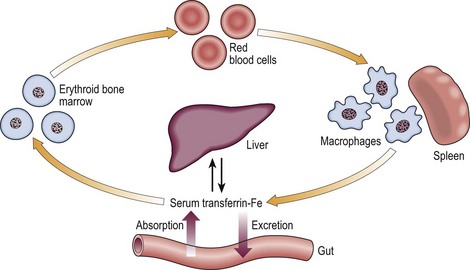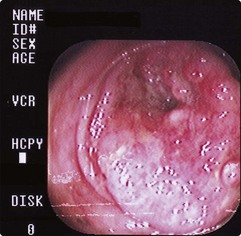12 Iron is a constituent of haemoglobin and rate limiting for erythropoiesis. The metabolism of iron in the body is dominated by its role in haemoglobin synthesis (Fig 12.1). Normally, the total iron content of the body remains within narrow limits: absorption of iron from food (usually up to 3–4 mg/day) must replace any iron losses. Iron is not excreted as such but is lost in desquamated cells, particularly epithelial cells from the gastrointestinal tract. Menstruating women will lose an additional highly variable amount of iron, and in pregnant women the rate of iron loss is about 3.5 times greater than in normal men. The storage forms of iron, ferritin and haemosiderin, constitute about 13% of total body iron. The small peptide hepcidin plays a key role in iron metabolism and absorption (see p. 36). Fig 12.1 The normal iron cycle. The likely cause will vary with the age, sex and geographic location of the patient (Table 12.1). Iron deficiency is usually caused by long-term blood loss, most often gastrointestinal or uterine bleeding and less commonly bleeding in the urinary tract or elsewhere. Particularly in elderly patients, deficiency may be the presenting feature of gastrointestinal malignancy (Fig 12.2). Hookworm infection is the commonest cause of iron deficiency worldwide. Malabsorption and increased demand for iron, as in pregnancy, are other possible causes. Poor diet may exacerbate iron deficiency but is rarely the sole cause outside the growth spurts of infancy and teenage years.
Iron deficiency anaemia
Iron

Iron is absorbed from the gut into plasma where it is transported to the bone marrow for haemoglobin synthesis. Dying red cells are engulfed by macrophages in the reticuloendothelial system, and iron is recycled into the plasma for reuse. Iron is transported in the plasma bound to the glycoprotein, transferrin. Transferrin receptors exist on most cells in the body. Of the total 4–5 g of iron in the body only about 0.1% is being recycled at any given time. The rest is in tissue-specific proteins such as haemoglobin (66% of total body iron) and myoglobin, or stored in ferritin.
Causes
Iron deficiency anaemia











